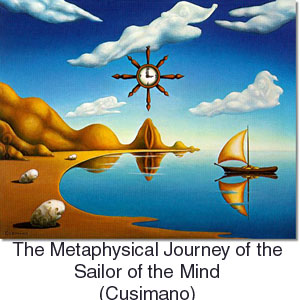

Connections Through Time, Issue 7: April - June 2000
![]()
 The SubConscious (SC) is a rather important, although generally ignored part of each of us. The capabilities of the SC that we take for granted are rather remarkable! In addition to the psychological aspects discussed in the previous section, the SC takes care of your breathing, heart beating, and most of the complex "automatic" activities we do every day, such as walking. The last thing you would want to do is to have to think about moving each of the muscles involved in taking a single step! What other capabilities might the SC have?
The SubConscious (SC) is a rather important, although generally ignored part of each of us. The capabilities of the SC that we take for granted are rather remarkable! In addition to the psychological aspects discussed in the previous section, the SC takes care of your breathing, heart beating, and most of the complex "automatic" activities we do every day, such as walking. The last thing you would want to do is to have to think about moving each of the muscles involved in taking a single step! What other capabilities might the SC have?
Science does not understand the details of how the human nervous system can guide our bodies through rather complex physical tasks based on something as subtle as an intention. All you need to do is intend to walk, and presto, you're walking. Learning to walk is a bit harder, but with the intention to learn how to "do it", with a deep desire to succeed, with practice and feedback (like falling when you do it wrong!), and with persistence, you do master the complex skill of walking. Stop for a moment to realize that it is truly your SC that has learned to walk. Your SC learns it so well, that you no longer have to be conscious of "trying to walk". You can go on "automatic".
Precognition is like walking. Science doesn't understand how it works, but with the intention to learn how to "do it", with a deep desire to succeed, with practice, feedback, and persistence, you can master this skill. You don't understand how you walk, and you won't understand how you can predict future events with better than chance odds, but you can do both.
P-I-A focuses on creating an environment where people can train their SCs to "do precognition" when desired. We also focus on developing practical applications. We recently funded 7 people to view the future as part of the AVM Project. This project involves the prediction of the nature of an Animal, Vegetable, or Mineral (AVM) target-photo that will be chosen in the future based on random associations with changes in future stock prices.
There are different approaches for training the SC and conscious "minds" to communicate with each other to do precognition. One approach that has been well-documented is Controlled Remote Viewing (CRV). Four of the 7 viewers used an "ideogram" approach adopted from their CRV training with the assistance of Lyn Buchanan, who was a consultant on this project.
An ideogram (defined more precisely below) is a type of automatic writing, with subsequent probing, of a "doodle" that is intended to distinguish different types of target gestalts. In our case, the three gestalt types are Animal, Vegetable and Mineral. The ideogram approach illustrates how the SC (we use SC to include the "unconscious") is central to getting predictions. Here are quotes from the published CRV manual used by the U.S.government to train CRVers.
"... remote viewing theory postulates a non-material "Matrix" in which any and all information about any person, place or thing may be obtained through the agency of a hypothesized "signal line." The viewer psychically perceives and decodes this signal line and objectifies the information so obtained.
Definitions: (selected)
2. Discussion:
RV theory relies on a rather Freudian model of human consciousness levels. The lowest level of consciousness is paradoxically named the "unconscious." All this label really means is that that part of our mental processes we know as physical "awareness" or "consciousness" does not have access to what goes on there. It is apparently this part of the individual's psyche that first detects and receives the signal line. From here it is passed to the autonomic nervous system. When the signal line impinges on the ANS, the information is converted into a reflexive nervous response conducted through muscular channels controlled by the ANS. If so allowed, this response will manifest itself as an ideogram. ...
f. Conscious: Perceiving, apprehending, or noticing with a degree of controlled thought or observation; recognizing as something external. Present especially to the senses. Involving rational power, perception, and awareness. By definition, the "conscious" part of the human being is that portion of the human consciousness which is linked most closely to and limited by the material world.
g. Autonomic Nervous System (ANS): A part of the vertebrate nervous system that innervates smooth and cardiac muscle and glandular tissues, governs actions that are more or less automatic, and consists of the sympathetic nervous system and the parasympathetic nervous system (Webster's 3rd Int. Unabr.).
h. Ideogram (I): The reflexive mark made on the paper as a result of the impingement of the signal on the autonomic nervous system and its subsequent transmittal through this system to the arm and hand muscles, which transfers it through the pen onto the paper.
Three viewers used less formal techniques, in particular, "hunches". However, all viewers intended to acquire the precog info from their SCs and communicate with their conscious minds to report the predictions.
This first funded application uses what we call Protocol-1 and will be discussed in the next section.
Go to another section of this issue:
Physics: The SubConscious (SC) and the Self Applications: AVM Precognition Project: Summary of Results for Protocol-1
![]()